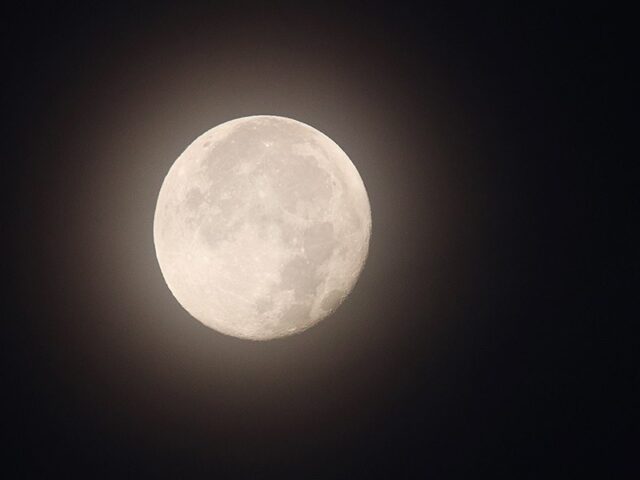
The people of the Dallas/Fort Worth metroplex are fortunate to share our city with a wide variety of urban wildlife. We have here in the city just about every variety of mammal, bird, reptile, amphibian, fish, and invertebrate that you might expect to find anywhere in North Texas.
Many species are active all throughout the day, which works in our favor when trying to have a look at one. But other critters restrict their activities to the night, preferring to go about their business under the cover of darkness.
Finding out more about what these critters do while most of us are sleeping requires a little bit of extra effort. With the help of my trusty trail cameras, I recently set out to gain some insight into the activities of the denizens of the dark. In this article we are going to take a closer look at nocturnal wildlife activity that normally goes sight-unseen.
Beaver Takeout
Beavers, the big dam-building rodents, are mostly nocturnal in their habits. They spend their days dozing in their dens or lodges, gathering strength for what is typically a very busy night. For the Beaver, the hours between sunset and sunrise are spent on a variety of activities. They fell trees and cut branches. They clear ponds of their reed beds; the cut cattails are packed with mud and used to construct dams. Beavers nibble on greens such as Pickerel Weed and Ragweed throughout the night. They build and maintain lodges. And they create scent stations soaked with castoreum to mark their territory.
Beavers also create well defined takeouts in places where they enter and exit the water. Because these spots can provide enhanced access to the water’s edge, they often become very popular with other species of wildlife as well. It’s not uncommon to find a number of game trails radiating away from a prime Beaver takeout.

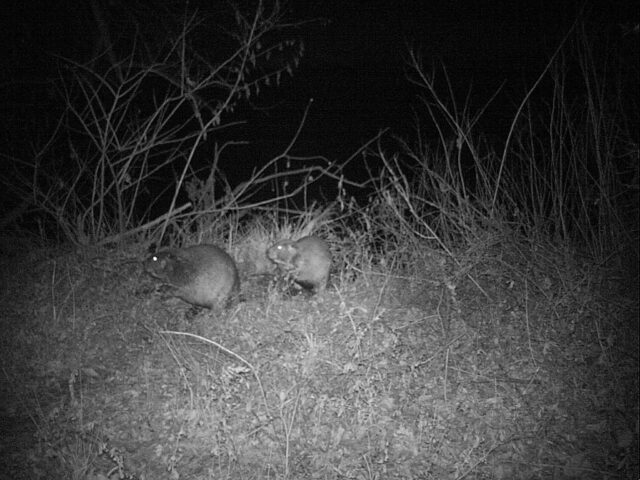

In this case a Bobcat stops by to investigate

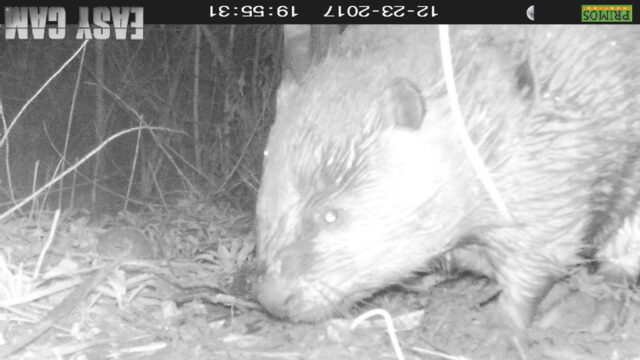


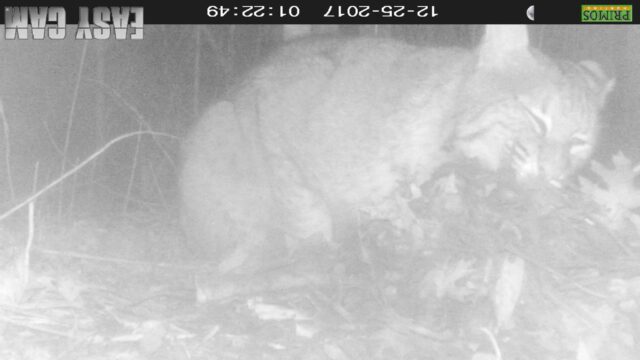
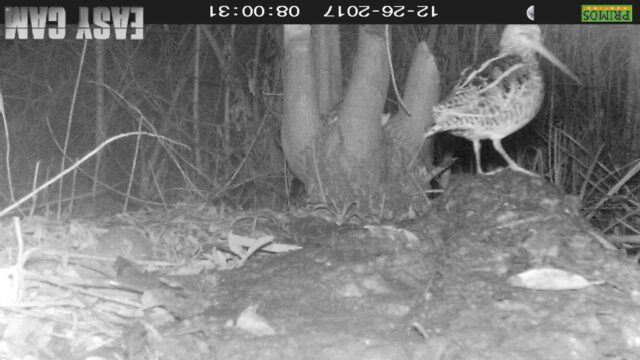
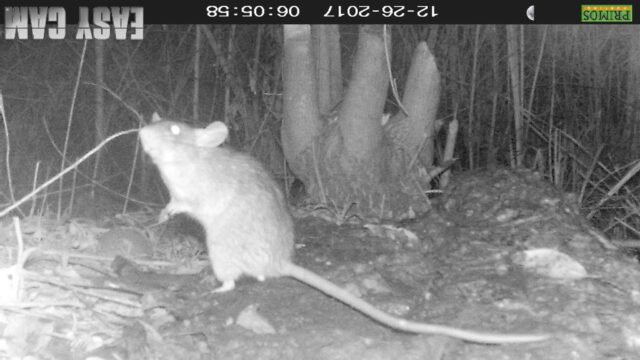

Front Porch Skunks
One afternoon my neighbor stopped me by the mailbox with something very important to tell me. Evidently, the night before they had spotted a whole gaggle of baby Raccoons milling about on my front porch. This was big news for me! I would definitely need to set out a trail camera and get some photos of the little rascals. That evening I set up a camera trap on my front porch, very eager to see the pictures it would record.
I got up early the next morning to pull the camera’s SD card, and inserted it into my computer so that I could view its contents. I could tell right away that a sizable number of pictures had been recorded. I selected the first thumbnail that caught my eye and double-clicked to enlarge it for a better look. To my surprise, the starkly black and white critter that appeared on my computer screen was definitely NOT a Raccoon. Instead, my camera had recorded photo after photo of a trio of juvenile Striped Skunks exploring every corner of my porch.
It turns out that the trio’s mother had dug her den under the stairs leading from the sidewalk up to our front door. The baby skunks had only recently grown old enough for their first exploration away from their home burrow. Naturally, they ended up on my front porch!
When I think back to this occurrence, I am reminded that we had just brought home our first dogs just a few weeks early. Two young lab-mixes, both with lots of puppy energy. In an effort to help burn off some of that excess mojo, we walked the dog several times a day—blasting out the front door on each ocassions. In retrospect is clear that we were very lucky that we didn’t discover the skunk family in a much less charming way.
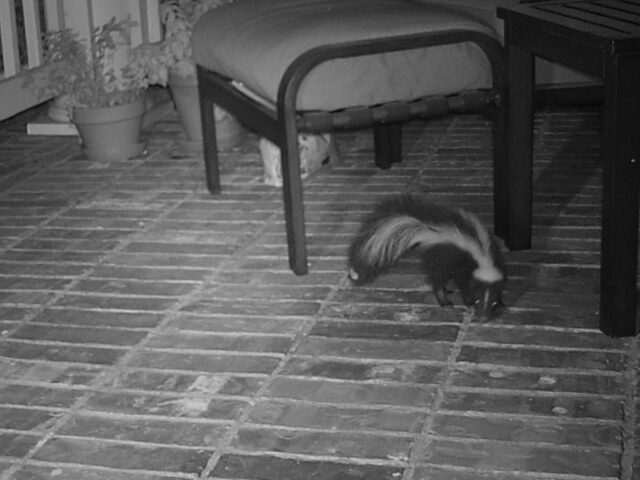
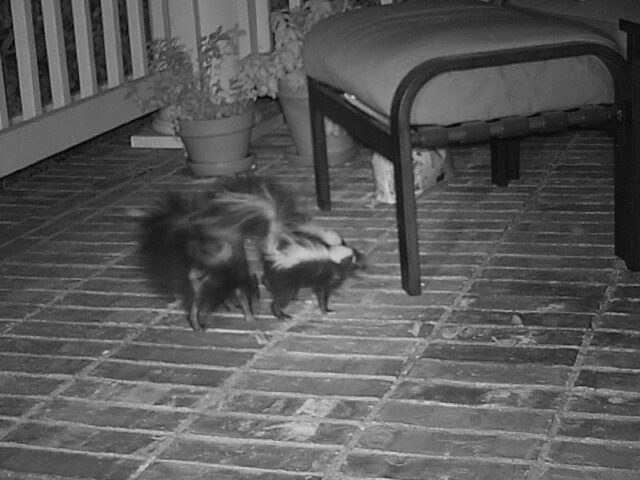
Neighborhood Bobcat
Bobcats are regular visitor to our yards—especially after dark. Most all neighborhoods in Dallas/Fort Worth can be expected to have a number resident Bobcats at any given time. But Bobcats like to stay out of sight and are good at hiding; they are therefore seldom seen. That doesn’t mean they are not present. These wild cats are small enough to find cover behind a minimal amount of landscaping, and they are even clever enough to use the storm sewer system as a covert subway system as they move around our neighborhoods. Their nocturnal habits make it even more unlikely that you will see one.
The easiest way to judge the likelihood of Bobcats being present in your neighborhood is make note of the other wildlife living there that you can spot during the day. If you have rabbits, and squirrels, and doves—favorite prey animals—frequenting your subdivision, then you most likely also have resident Bobcats!
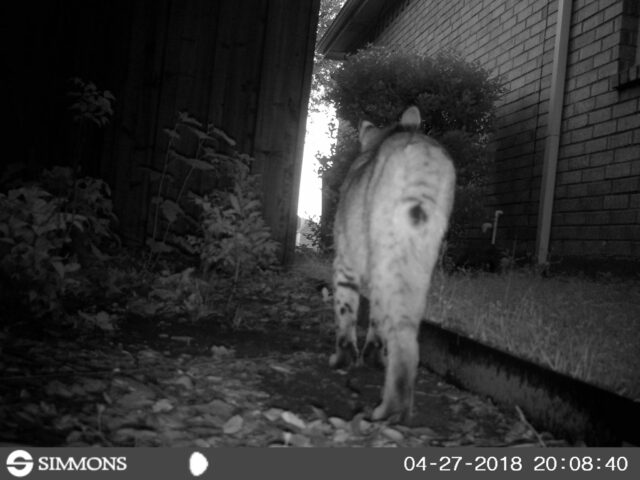
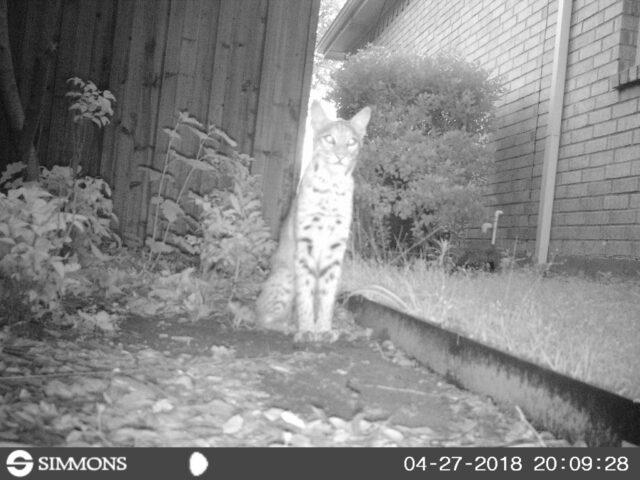
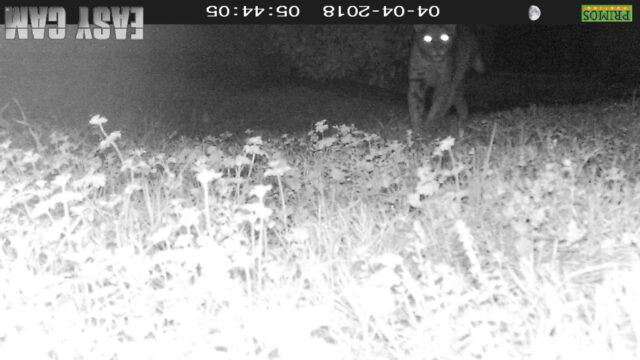

Bird Feeder Rats
Understandably, not everyone will be excited to learn about this particular flavor of nocturnal urban wildlife. We have several different species of rats sharing the metroplex with us… There’s the Black Rat, the Norwegian Rat, the Hispid Cotton Rat, and the Eastern Woodrat. All are very resilient and adaptable. They thrive in our neighborhoods, business parks, shopping centers, and in the undeveloped areas in between. No matter where you live or what you do, some number of rats will always be present.
In the case of the pictures below, these Black Rats have come to a bird feeder late at night to gorge on sunflower seeds. Contrary to popular belief, bird feeders are not the reason we have rats in our neighborhoods. There is plenty of foodstuff for them to eat around our homes, even without the bird seed. But, bird feeders do concentrate the activity of rats in one particular spot, and that can be a problem, especially if they find an easy segue from there into your house.
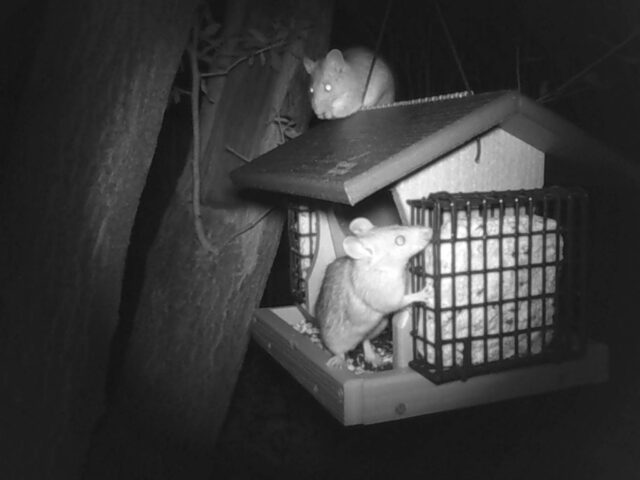

Storm Sewer Bobcats
I mentioned earlier in this post that Bobcat use our neighborhood storm sewer systems to move around underground… Well, here’s the proof! I dropped a little trail camera/tripod combo down into one of our street runoff drains, and in just a fews days I had a nice collection of subterranean Bobcat pictures!
This dainty little female Bobcat moves from storm drain to storm drain underground by following the interconnected network of pipes. In the pictures below you will see her enter the drain through a pipe outlet. She continues in far enough to investigate my cameras, before turning back and exiting the same way she had just come.
What’s more, this clever momma actually raised a litter of kittens down in this system of manmade caverns. The sound of baby Bobcats playing and wrestling in the leaf litter covering the bottom of this storm drain is what first drew my attention. Once I had seen the playful kittens, I knew I’d have to come back with a camera trap to learn more about what was going on under the ground in my neighborhood!
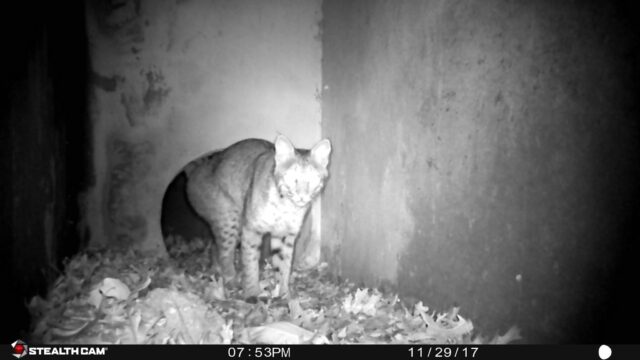
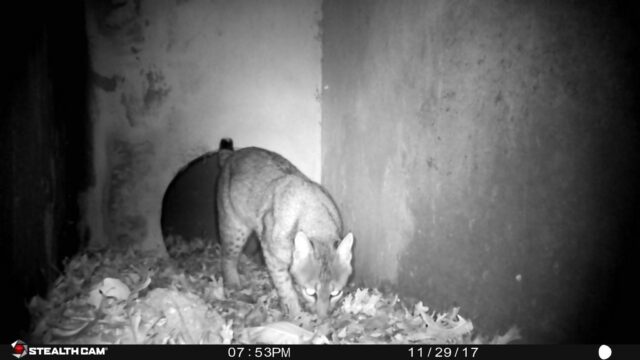
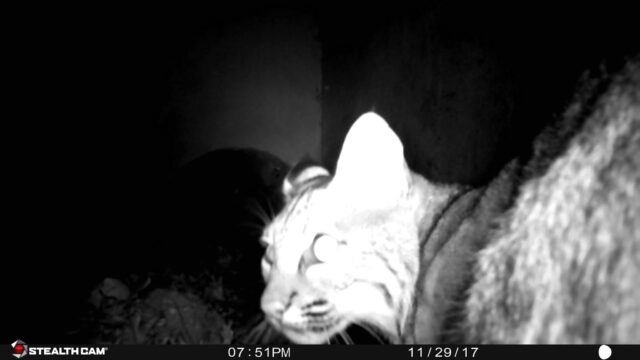
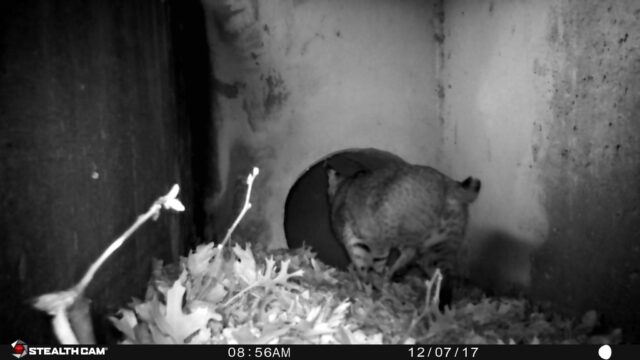
Screech Owls
There is something special about owls. Somehow they are a little different from other birds… Maybe it is that they have a face and can appear to emote—much more so than with many other avian species. In any case, people love owls, and fortunately for those of us living in Dallas/Fort Worth there is a species of owl that is perfect to invite into your own backyard!
Meet the Eastern Screech Owl! This tiny little owl is about the size of a box of Pop Tarts. They come in several different colors—Brown, Gray, and Red. And, the Eastern Screech Owl sings a lovely, haunting trill that is occasionally augmented with a horse-like whinny.
These owls thrive in suburbia. All it takes to attract them to your yard is a few trees and an owl box built to the proper specs. Install one near your house, and before you know it you’ll have a family of these owls helping to manage the populations of rodents, reptiles, and other small critters found around your home!
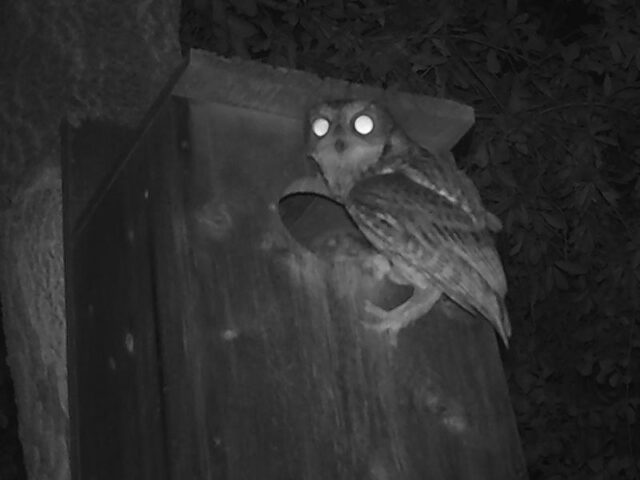

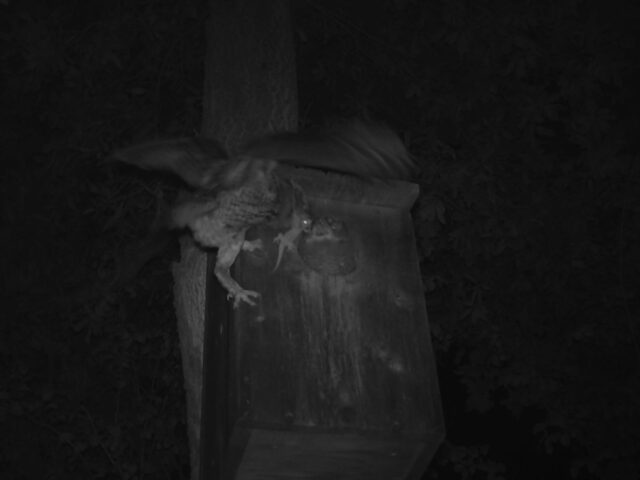
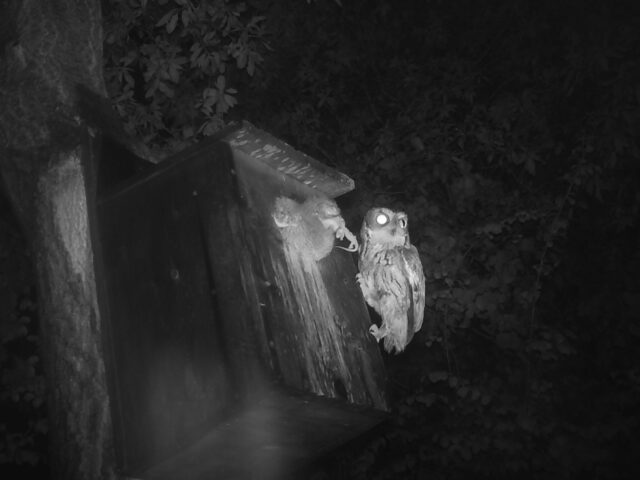
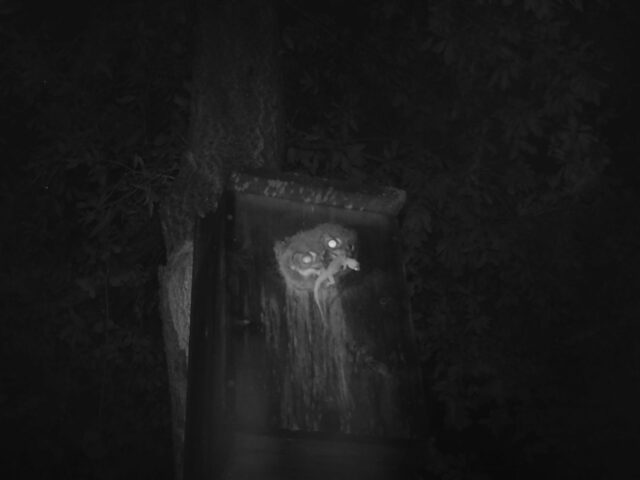
Urban Cemetery
There is wildlife to be found even in our most urbanized areas. The pictures below were all recorded in a small cemetery located in uptown just North of downtown Dallas. Every type of North Texas critter you might expect was photographed, along with a few surprises! Have a look!
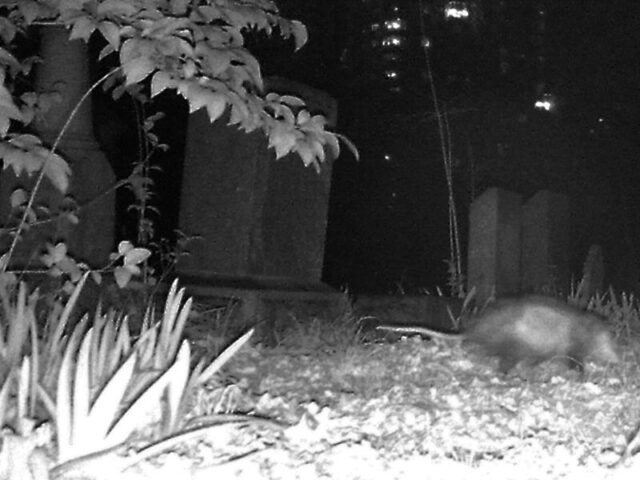

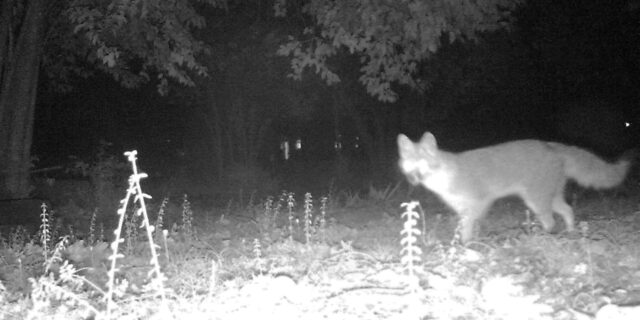
The Deadfall
Every so often, a large tree—blighted or in loose soil—will fall to the ground when a powerful storm system rolls through the Dallas/Fort Worth metroplex. The resulting deadfall is often an interesting place to setup a camera trap. The tree used for this collection of photographs was a massive Bur Oak with a trunk diameter of around 4 feet at the base—one of the largest trees in the immediate area.
For this set I mounted my camera inline on the top surface of the now horizontal tree trunk. Almost every night some critter or the other wandered by hoping to find something of interest on the fallen tree. Sometimes the animal was coming and sometime it was going—Face shots and tail shots resulted. Check the pictures below to see if you can identify the the animal from its undercarriage view. Checks your answers against the face shot pictures that follow!
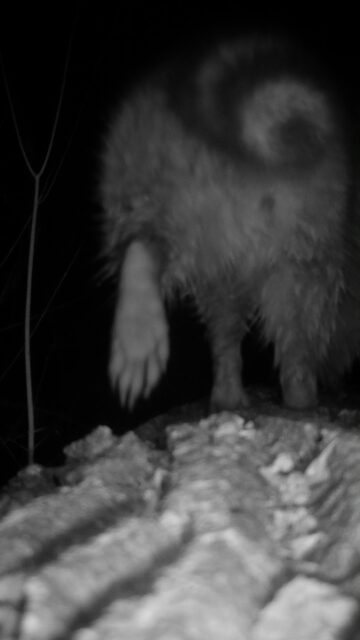
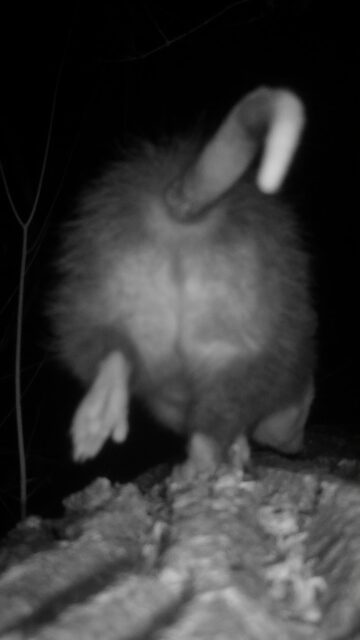
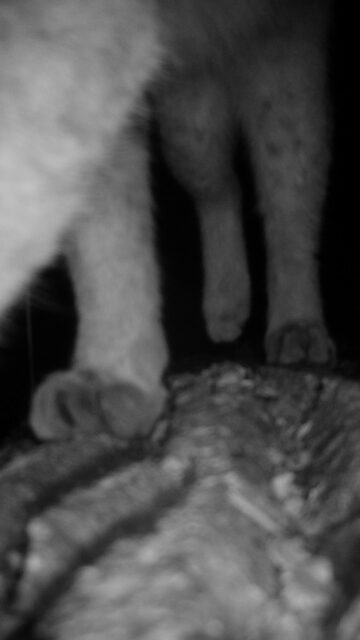

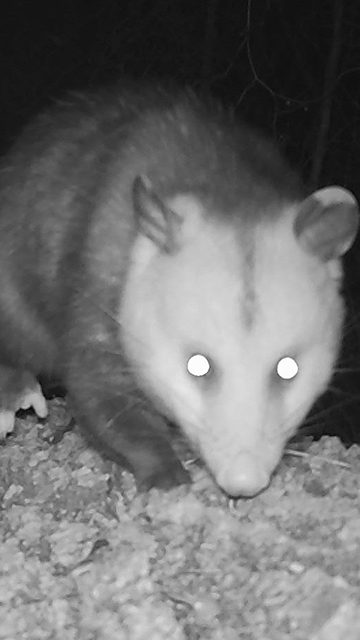
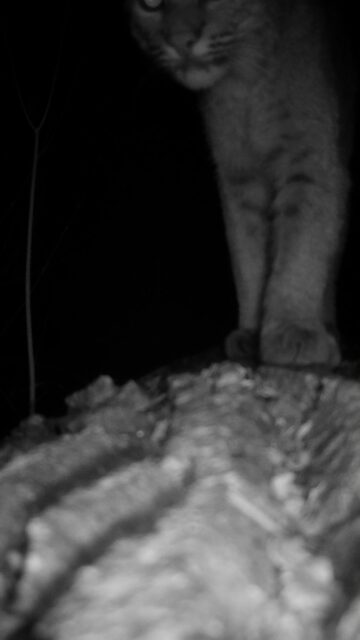
Deep Woods Does
Towards the end of summer and the beginning of autumn, White-tailed Deer females–along with their first year offspring—begin to form herds. Does are generally solitary while caring for their fawns over the summer, but this behavior pattern does a complete 180 as the cooler weather of fall approaches. It’s always a great pleasure to view the pictures that are recorded when one of these social groups spends some time in front a camera trap!
It is thought that this herding behavior benefits the first year fawns by gathering them into groups that will help them make the transition to independence. The young deer will soon be left to their own accord as their mothers’ attentions shift during the run up to mating season.
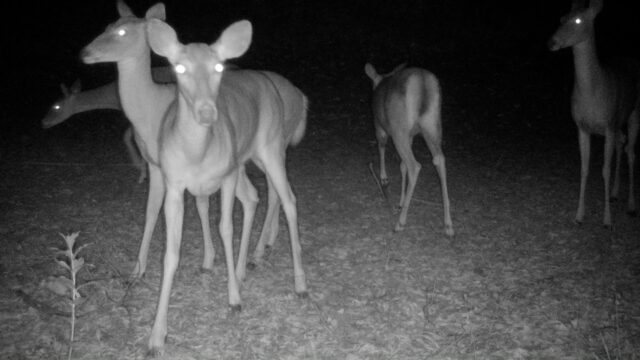
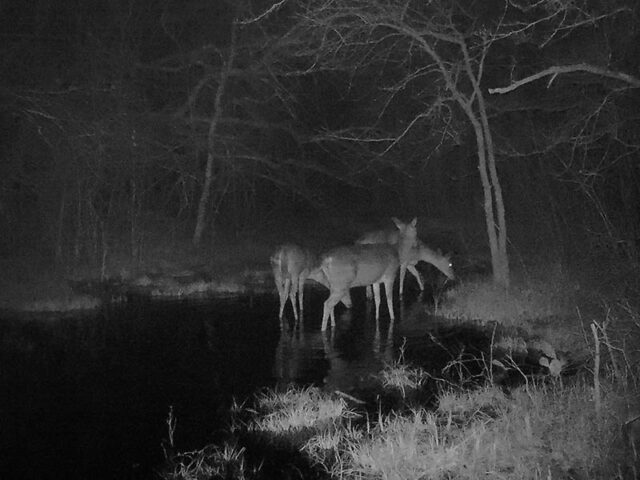
River Otter Takeout
Much as is the case with the American Beaver, Dallas/Fort Worth area River Otters also have preferred places to haul themselves out of their watery homes and onto dry land. These takeouts may be in support of a communal otter latrine, or maybe they are just a particularly good spot for otters to sit and eat crayfish. Other times these takeouts may connect long game trails used by the otters to move between one body of water and another. Whenever an otter take out is used by a family group there can be a lot of activity for a trail camera to record. See below for some photographic examples…

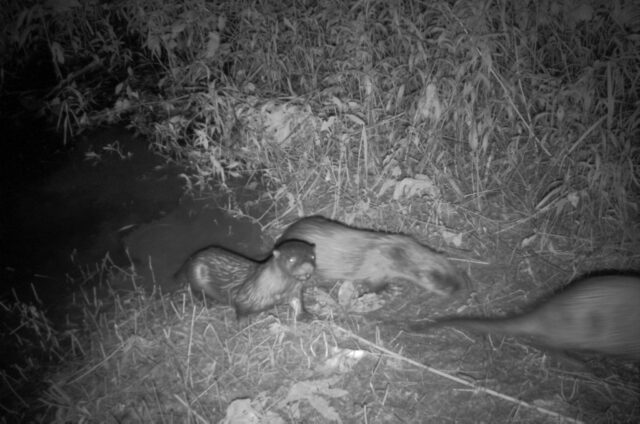
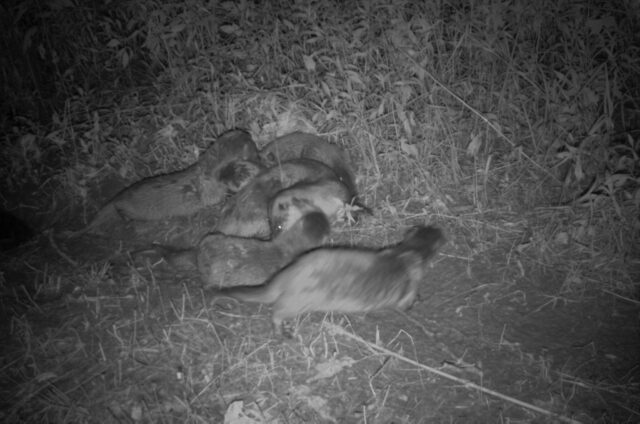
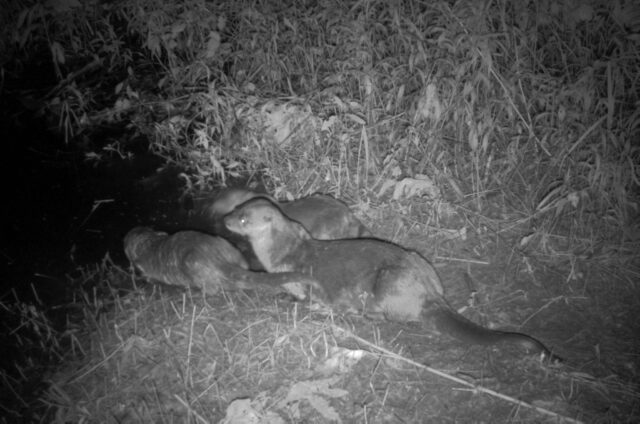
Coyotes
Coyotes can be active all throughout the day, but our urban Coyotes have become especially adept at operating after dark. These wild canines have many activities that keep them busy during the nighttime hours. Among these are patrolling, hunting, protecting their territory, caring for their young, and sometimes even catching up on their rest.
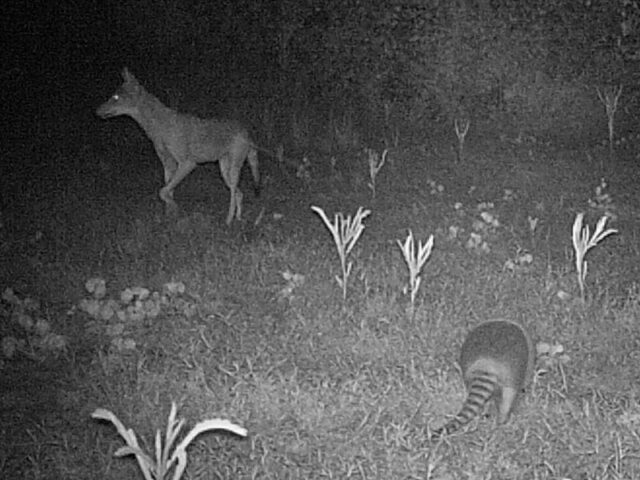
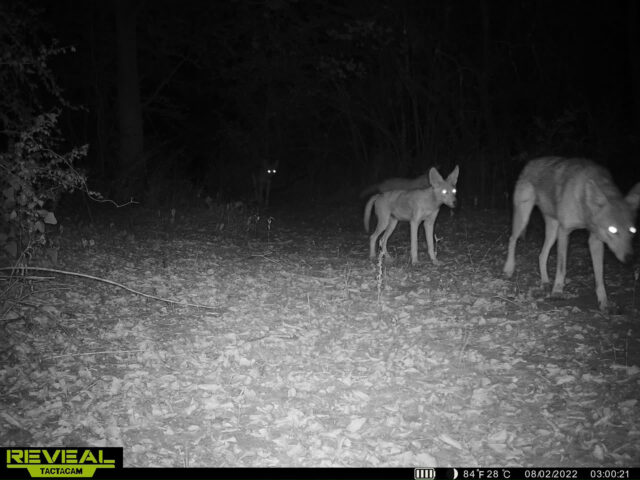
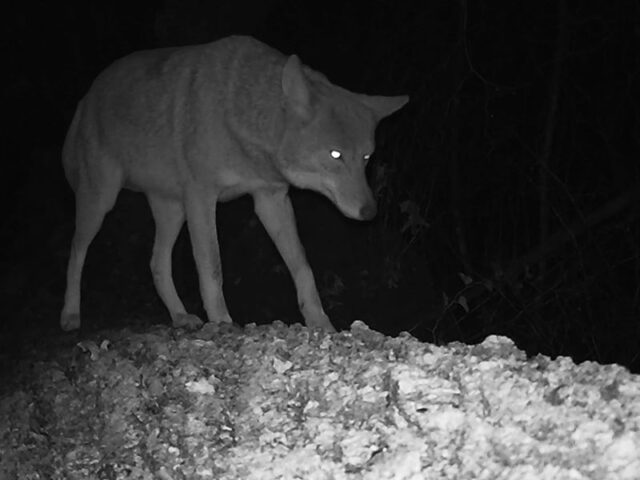
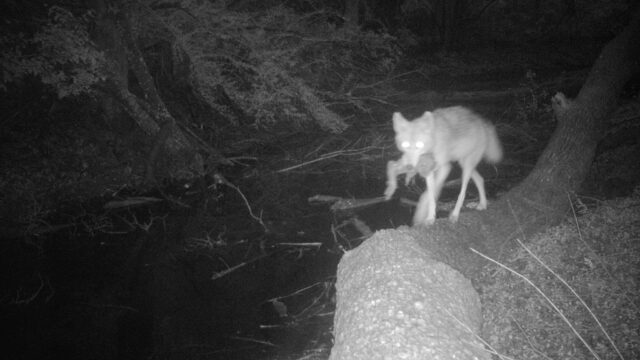
With a certain level of proficiency at tracking and sign reading you might—from time to time—stumble across a situation like the one illustrated in the pictures that follow. What we have here is a recently dried pond bed late in summer. The newly exposed flats were only beginning to sprout pioneering plant growth. And while the soil was dry and grainy, it was of a consistency that still allowed it to record tracks and other sign quite well.
One afternoon while I was out scouting for new places to leave my cameras, I noticed an abundance of Coyote tracks on the bare earth were the pond had been only a week before. Moreover, there were a number of places where it was clear that the Coyotes had scratched out beds for themselves, spending many nighttime hours recumbent on the cooler—and bug free—dry dirt.
I set several trail cameras around the old pond bed, leaving several to watch only a few feet from where I expected Coyotes to bed down for the night. Below you will find a sampling of the many pictures my cameras recorded…
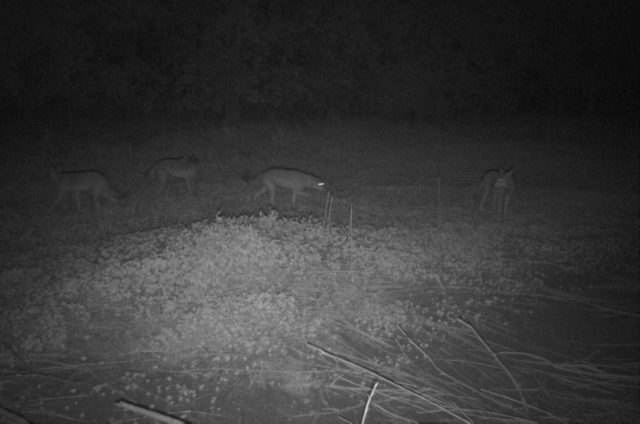

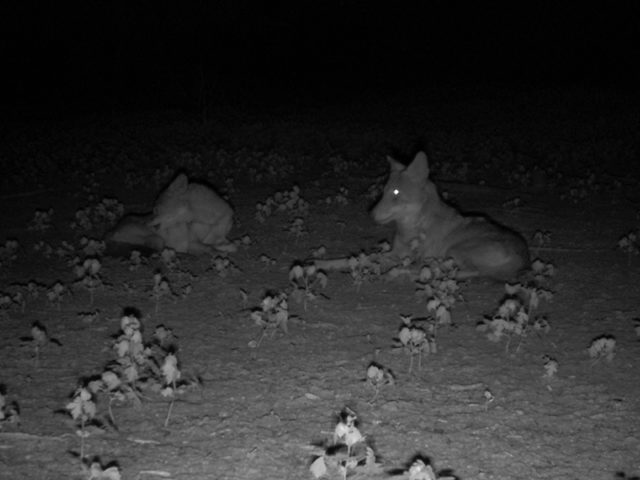
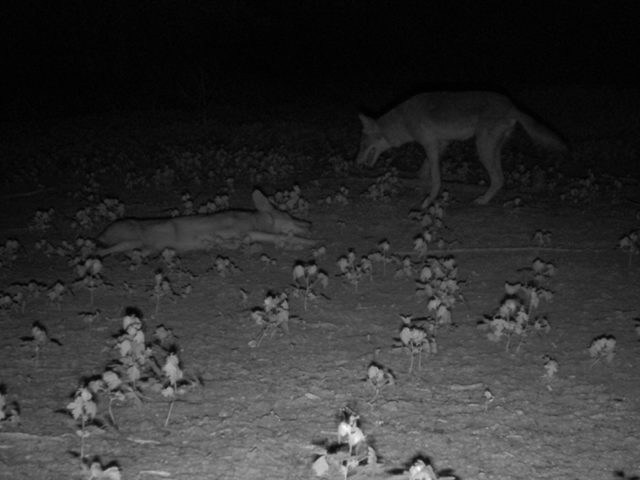
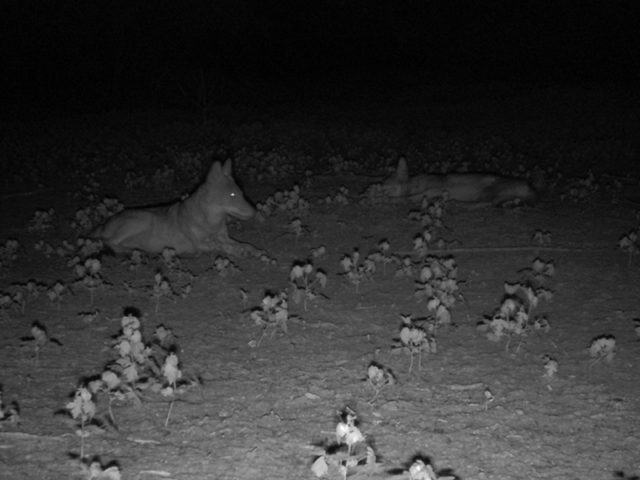

in the family group returning to the pond bed
Bedded Down Deer
White-tailed Deer also bed down in the woods when they need a break and/or have a cud to chew. Just by chance I set one of my cameras in a place where it would regularly capture a resting doe center frame. In this particular case I was using a cellular camera, which meant that any pictures it recorded would be instantly uploaded to the cloud. I was able to keep tabs on this camera trap in real time! The doe’s favorite place to recharge her batteries quickly became one of my favorite places to watch remotely.
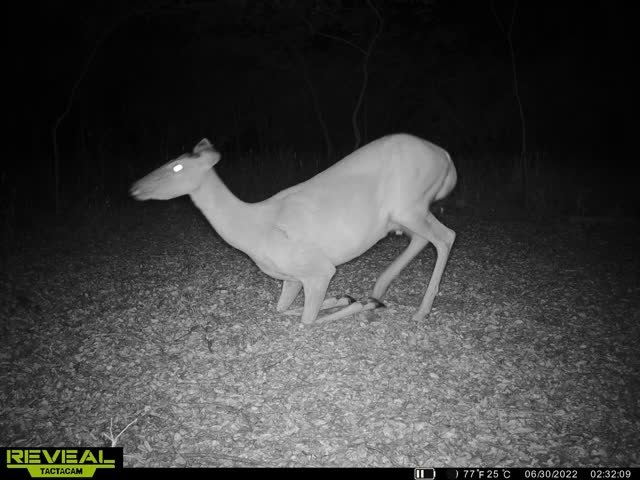
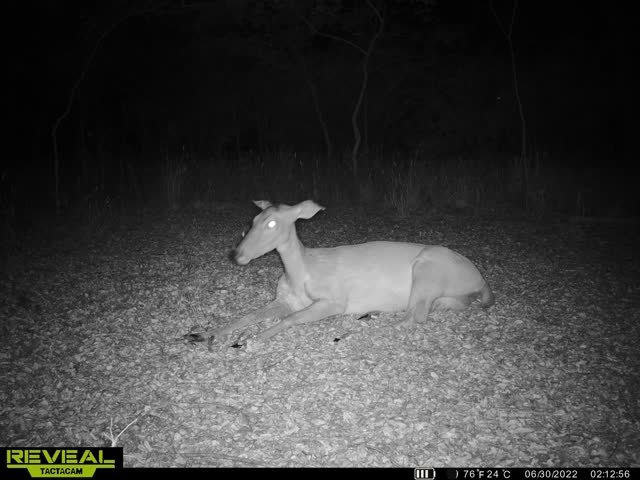

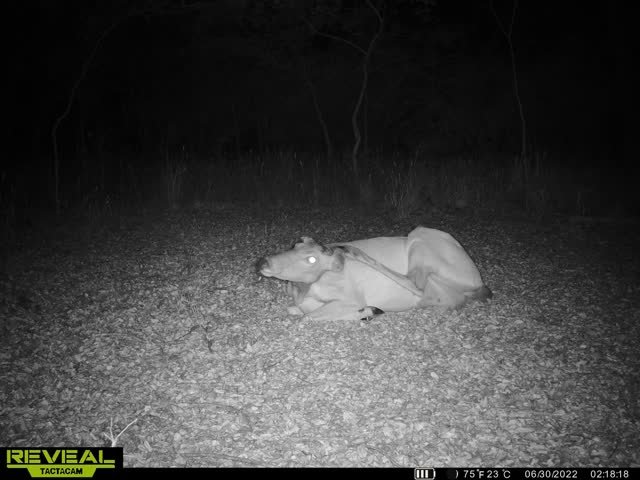
Sparring Bucks
Dallas/Fort Worth area bucks come out to spar in the twilight hours. There are places deep in the Trinity River bottoms where vernal pools keep the forest floor clear of underbrush. These open areas become arenas hosting virtual cage matches between sparring bucks. On late autumn evenings, after the weather has turned colder, you might hear the thunder of clashing antlers coming from deep inside the forest. If the sound reaches your ears, be sure there is a mighty battle taking place within!
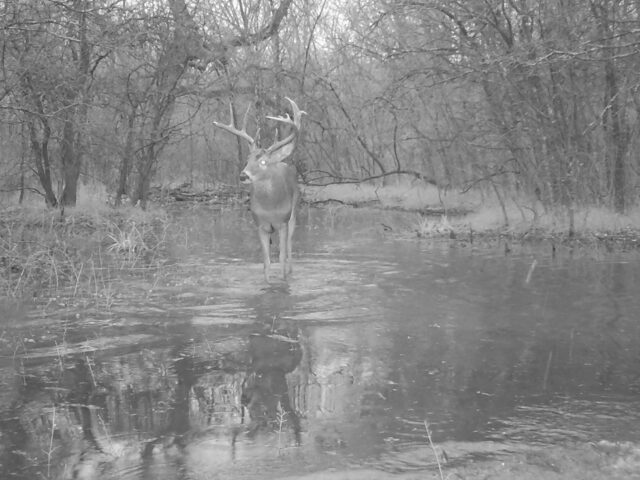



The Burrow
I found this dugout located about halfway up a tall embankment that gave way to an expansive urban creek valley. The drop off formed the boundary between a residential subdivision and a well developed greenbelt park. The area was loaded with wildlife, and I couldn’t help but to be interested in learning more about how the resident animals used this burrow. I left a trail camera behind to see what there was to see.
It turns out that the burrow was a very busy spot after dark. Many different animals came to investigate its mysteries. Some stayed for extended periods, and others did not. Most just showed a passing interest, but those critters who stayed never spent more than a few hours in the burrow. All in all, this hole in the ground was used much more like a hotel than like an apartment.

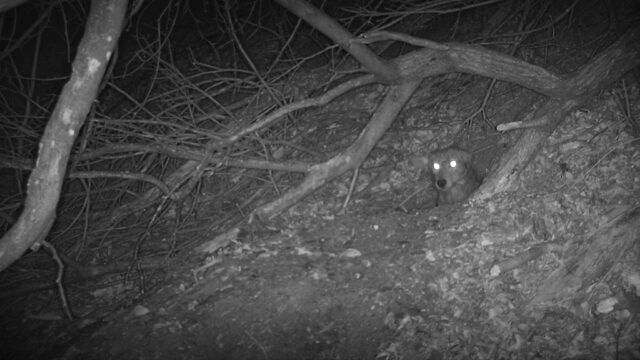

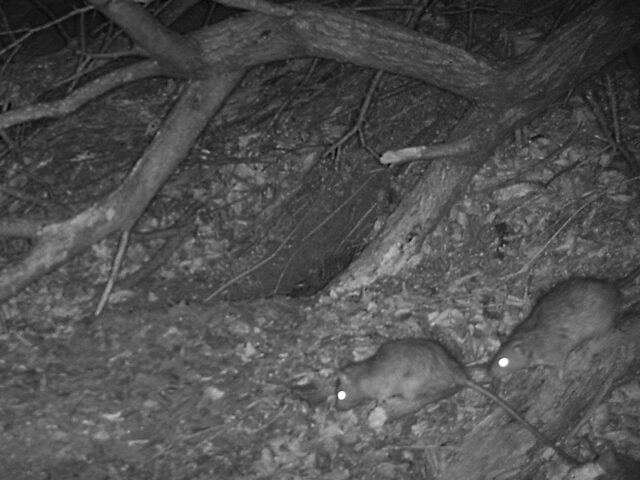
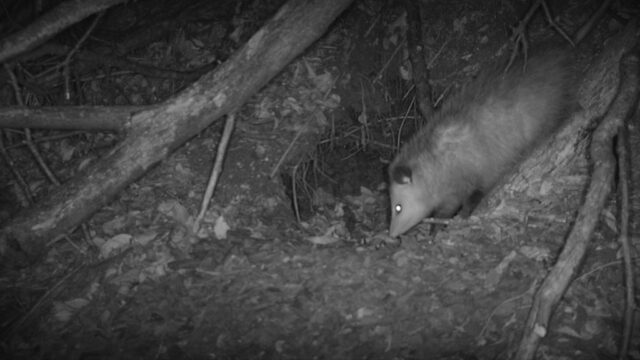
using the burrow for shelter and extended stays.
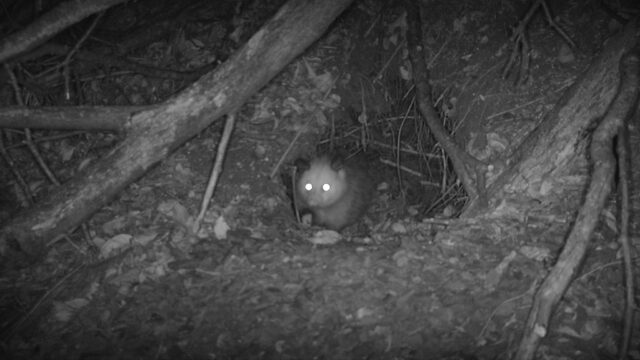
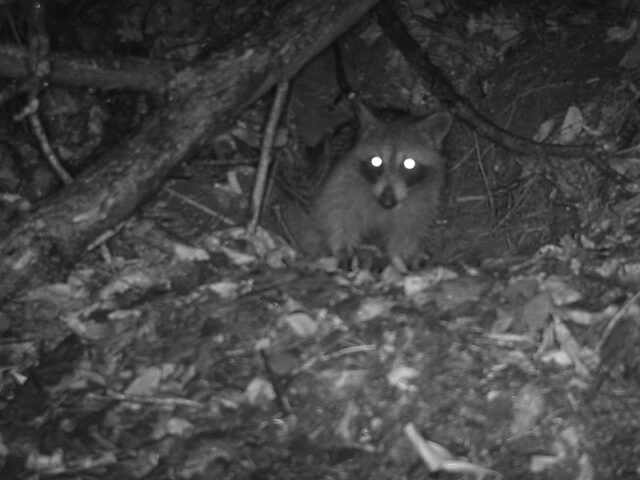

Opossums and Coyotes
The following set of pictures is pretty cool. This amazing sequence of photographs is largely the result of serendipity. I left a couple of trail cameras in this spot mostly based on a gut feeling. Within a few days it became evident that there were many Opossums that moved through the area regularly. Several different individuals seemed to be using this location as their route between a creek and its adjacent neighborhood.
Opossums are not my favorite animals, but the unusual number of times they passed though the area piqued my curiosity. I decided to let the camera trap run for longer than I would have ordinarily. The dramatic footage that was recorded made the effort more than worth it. See the pictures below!

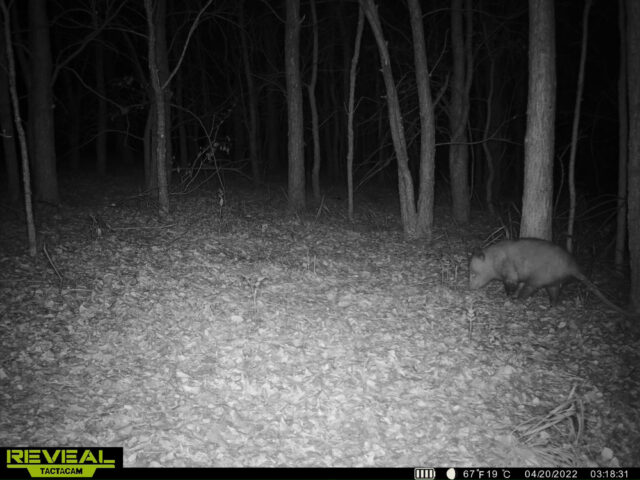
On this night he spent a considerable amount of time in front of the camera
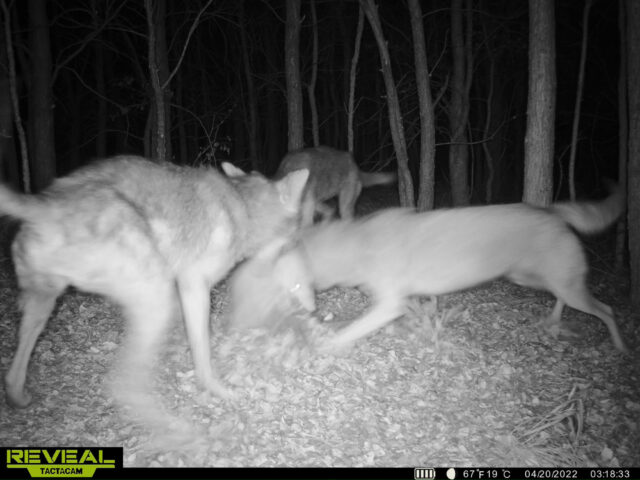

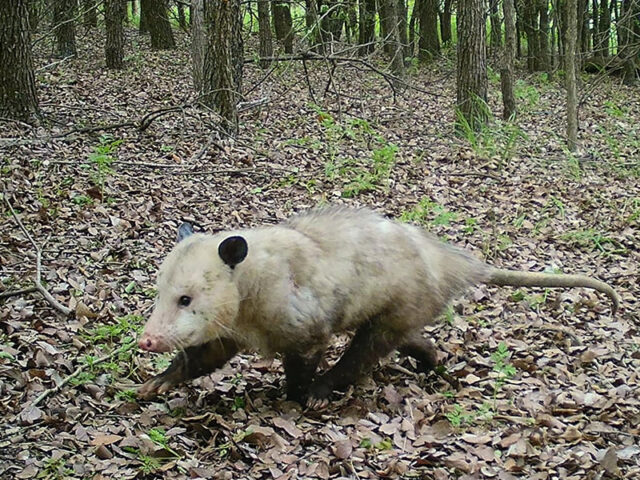
is the same Opossum, little worse for the wear. There may be a slight injury
to his left shoulder, but other than that he seems to be doing fine
Horse Apples
Have you ever wonder what—if anything—eats those big green Horse Apples (also known as Osage Oranges)? I have read suggestions that the fruit of the Bois d’Arc tree is an anachronism—a hold over from another time. one theory I studied posited that it was big prehistoric mammals that originally fed on Horse Apples, and that the tree had evolve to satisfy their tastes and habits. In return the megafauna spread the seeds the Bis d’Arc tree. The implication was that modern mammals might have little use for the Osage Orange. I decided to set some trail cameras to find out.
In short order it became apparent that the fruit of the Bois d’Arc was very popular with at least one modern mammal—the White-tailed Deer. In particular, It was the biggest bucks that demonstrated the most interest in eating Horse Apple over the course of my trail camera survey.
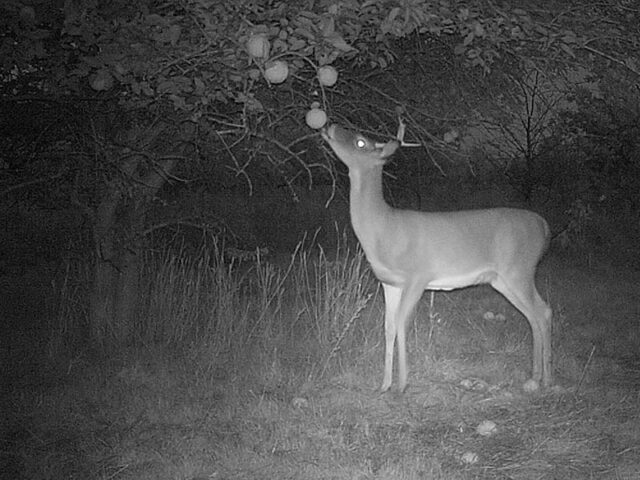
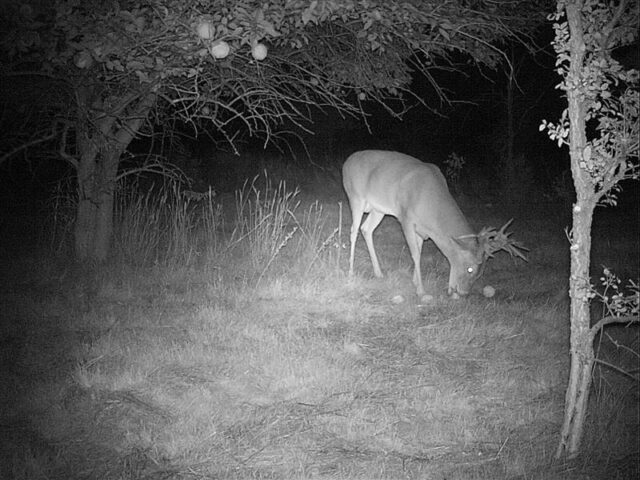
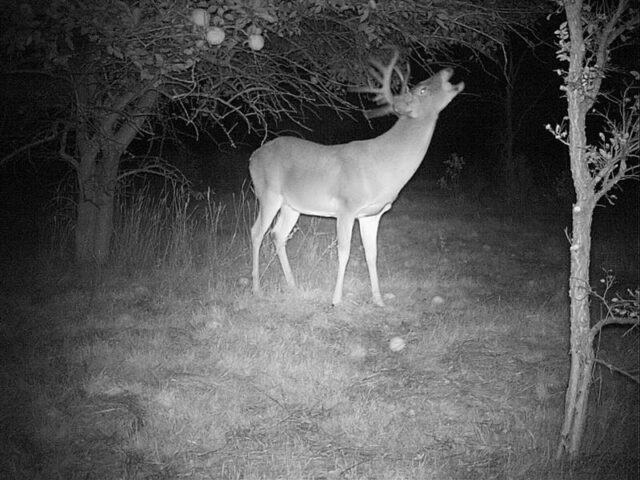
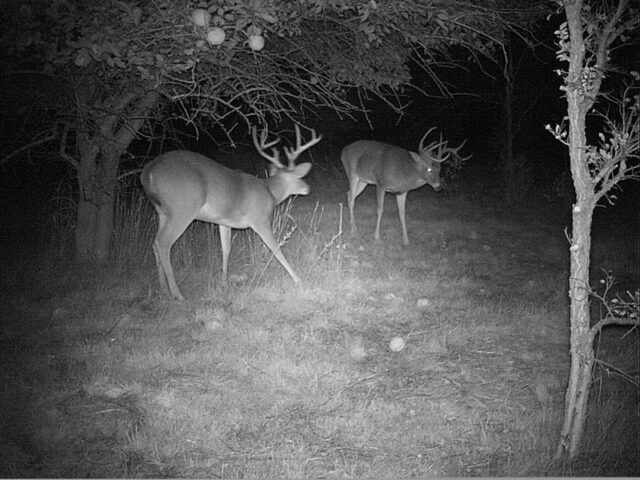

Raccoons
Raccoons are the rascals of the forest, there is no doubt. But, if you did happen to need some additional proof, trail cameras provide it in spades. We have lots of urban Raccoons in DFW—many folks would be truly shocked to learn just how many. And every last one of them gets into mischief, every single night. Raccoon antics are endlessly entertaining. It’s always a pleasure to see more of what my trail cameras have revealed about these intelligent and engaging critters!
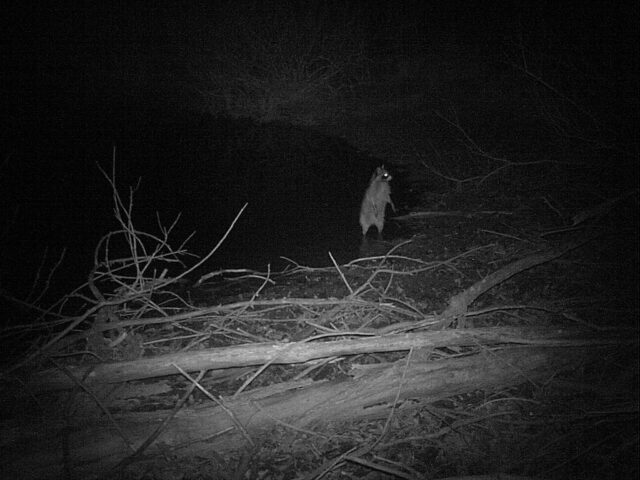
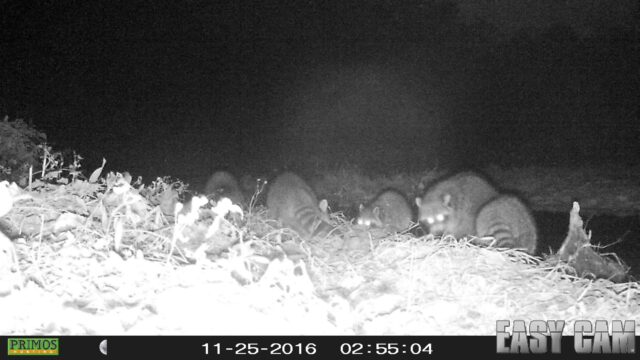
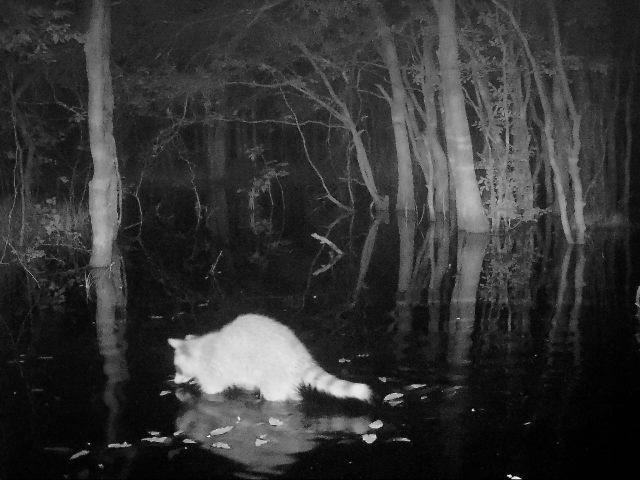
clever mammals are able to function in the dark of night
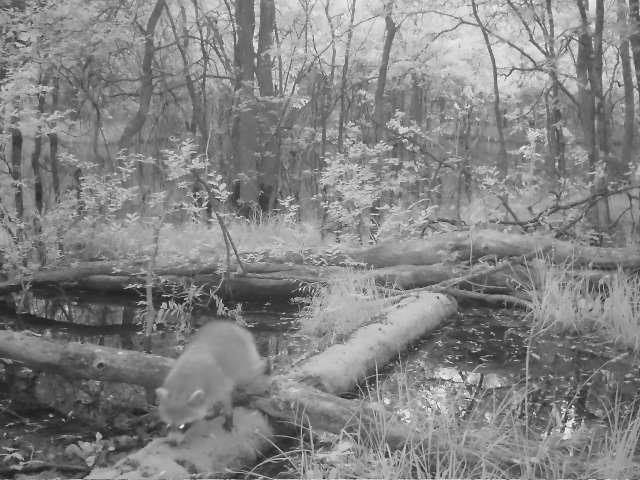
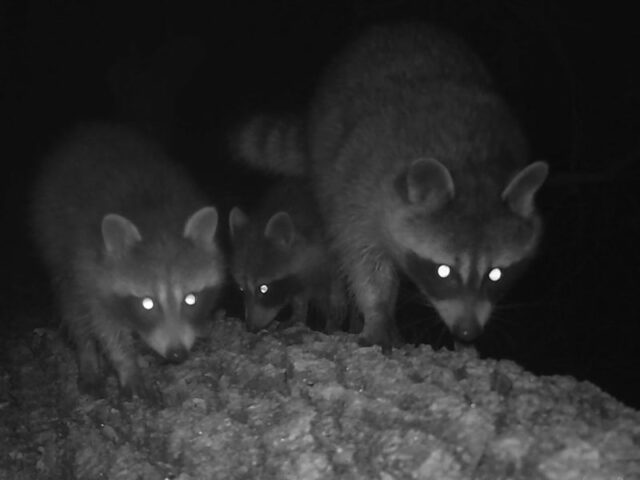

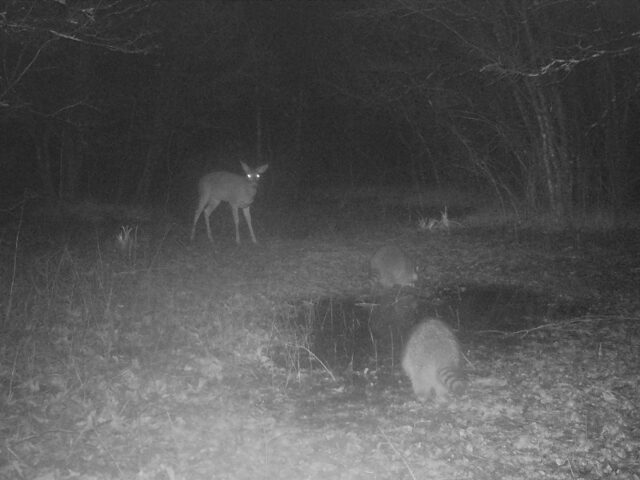
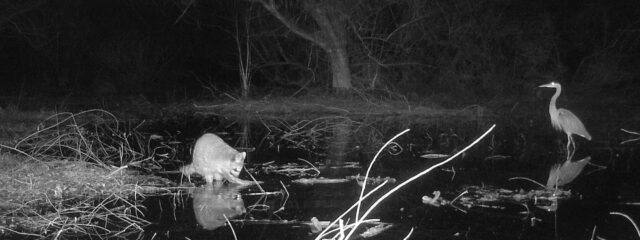

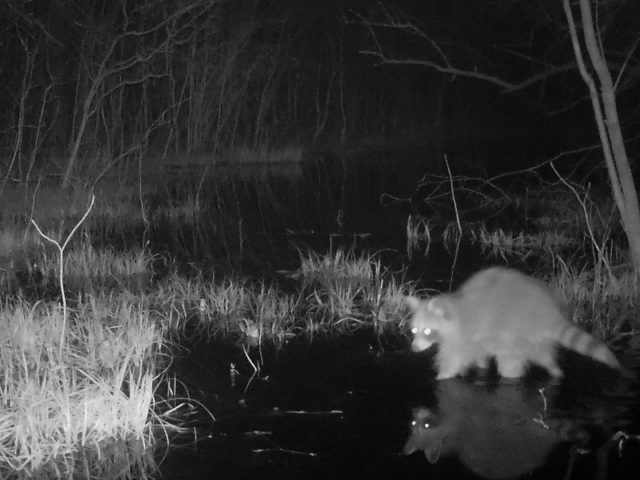
Wild Hogs
Feral hogs rule the night in the Trinity River bottomlands. When a sounder of these big and powerful mammals come through the forest all other creatures yield the right of way. Many people would be surprised to learn just how many wild pigs can be found in the metroplex. Feral Hogs by the dozens inhabit the Trinity River bottoms, as well as many of its feeder creeks. Many of the places they inhabit are also very close to highly urbanized areas. On occasion these resourceful and prolific mammals even make their way into our business parks and sports complexes.

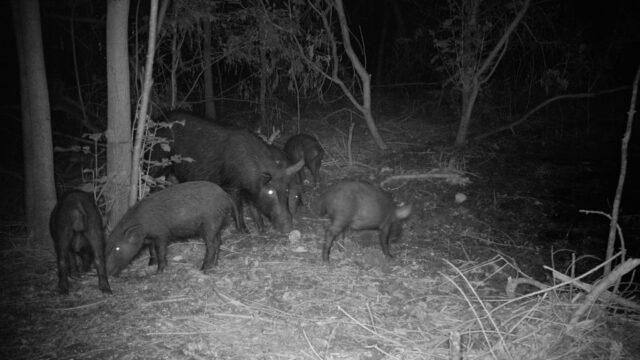
Night Herons
Night herons are so named for a very good reason… They are very active after dark! These medium-sized wading birds spend the dark hours preying on small aquatic animals. Crayfish are a favorite. In the pictures below you will find Yellow-crowned Night Herons hunting in what is little more than a drainage ditch, tucked into a forgotten corner of a Dallas-area business Park.
Yellow-crowned Night Herons are one of the two species of night heron living here in DFW—the other is the similar Black-crowned Night Heron. Both birds are roughly the same size. And both are gray in color—with only subtle differences in the details of their plumage, especially around the head and neck. Further, the Black-crowned Night Heron is generally more horizontal in its countenance, while the Yellow-crowned Night Heron carries itself in a more vertical position.
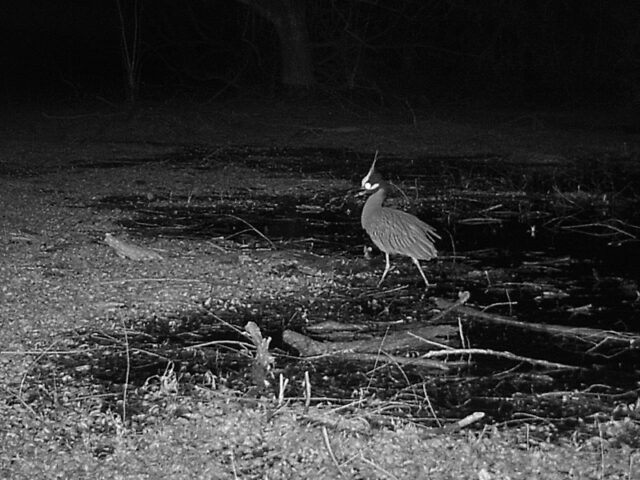

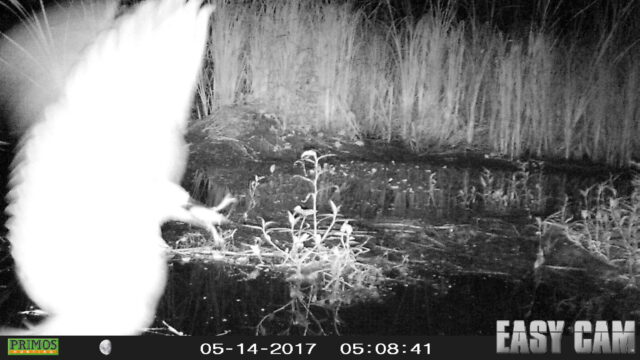
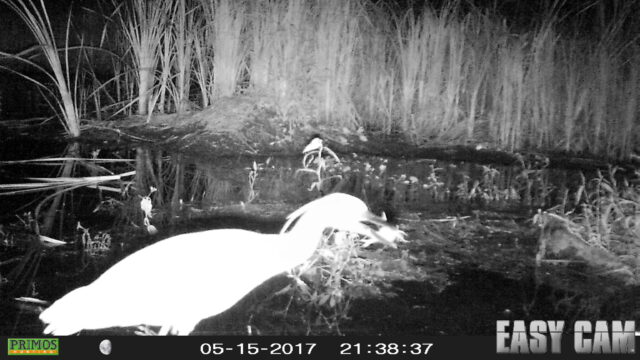
The little aquatic invertebrate still needs to be subdued.
Owls
It takes a little luck to record an owl with a trail camera, especially if they are not your primary objective. But no matter where you set a trail camera there is a chance that one of these nocturnal birds of prey will find their way in front of it. Places where small animals such as rats, mice, lizards, snakes, and frogs frequent will almost certainly attract an owl at some point.
We have three species of relatively large owls living here in Dallas/Fort Worth—the Barred Owl, the Great Horned Owl, and the Barn Owl. At one time or the other all three have made an appearance before my cameras.

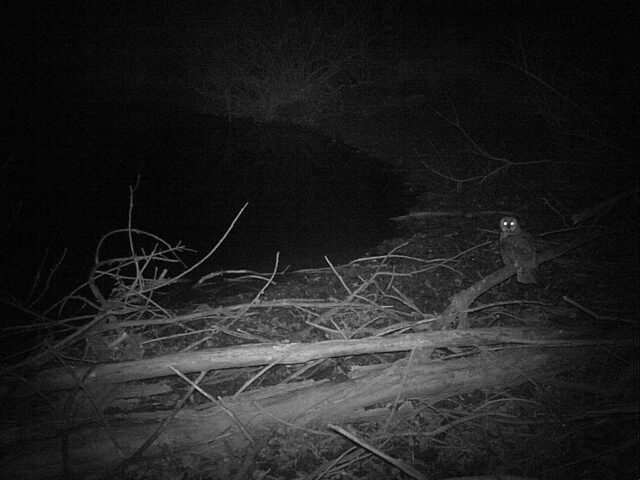
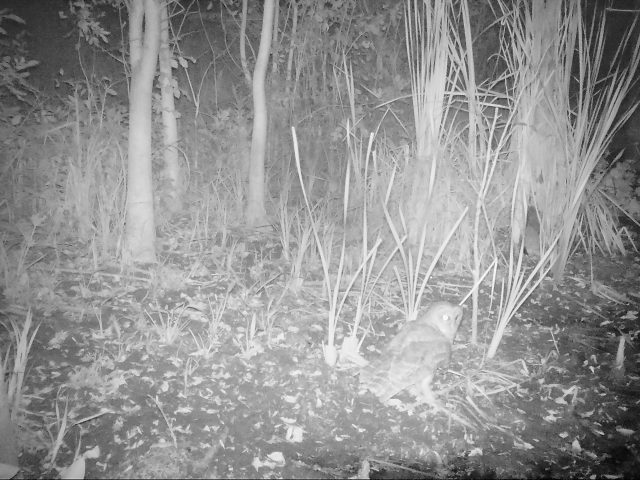
This one was likely hunting frogs or rats.
Swamp Rabbit
My first encounter with a Swamp Rabbit occurred many years ago. I was exploring deep in the Trinity River bottomlands in far south Dallas County when I flushed one just by chance. I was immediately struck by the size of the rabbit, and commented to my sidekick, “That was the biggest cottontail I’ve ever seen!”
For years I had been aware that there was a variety of cottontail known as a Swamp Rabbit, but on that day I was not well informed about their characteristics or habits. It did occur to me that this big bunny might actually be a Swamp Rabbit, but I had to do some research on the computer to verify that they are indeed much larger than the more common Eastern Cottontail we find in our neighborhoods.
There have only been a couple of occasions since where I have been able to record pictures of Swamp Rabbits. Fortunately, as in the case with the photos below, the camera trap locations proved to be a hot bed of wildlife activity, and the pictures of many different species of animals were also recorded. This allowed me to create a composite photograph to better illustrate the large size of the North Texas Swamp Rabbit—see below!
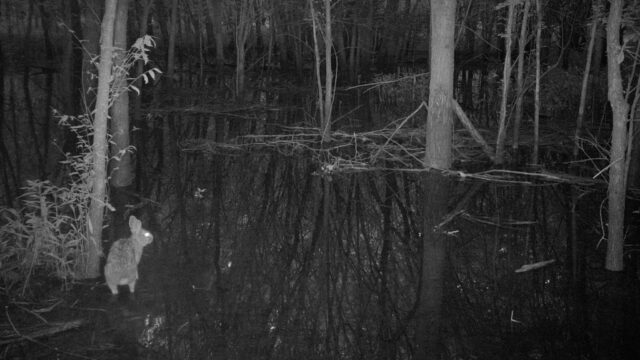
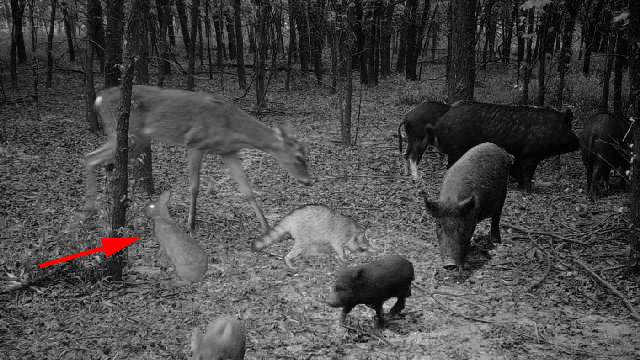
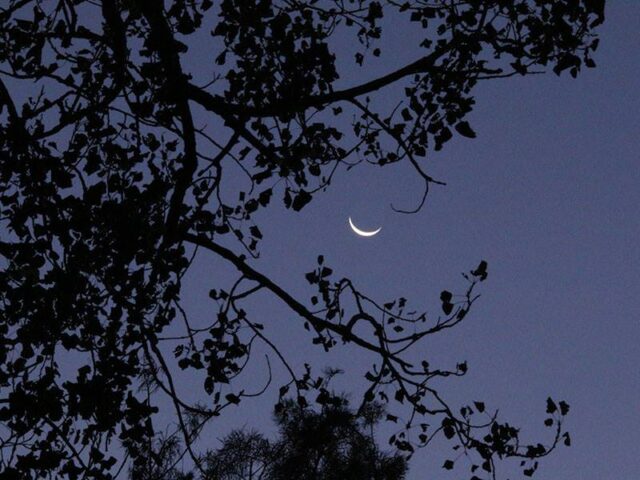
The dark of night can reveal a lot about urban wildlife that we wouldn’t ordinarily get to see. With the aid of a new generation of ever more capable trail cameras we can have a look at some of those secrets for ourselves. There is always something new to learn about our diverse body of urban wildlife, and there is always somewhere new to monitor with a camera trap. The possibilities are endless, and the rewards are immense. I hope you enjoyed this look at urban wildlife after dark. I’ll be out in the field again soon to record more photographs Dallas/Forth Worth wildlife making its way in the dead of night!



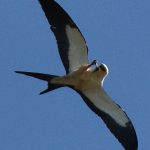
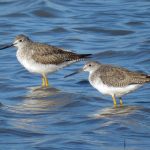

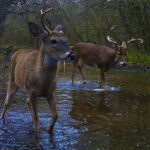
Excellent post! What trail camera make do you use? I am a novice and been mostly using a low cost generic cam.